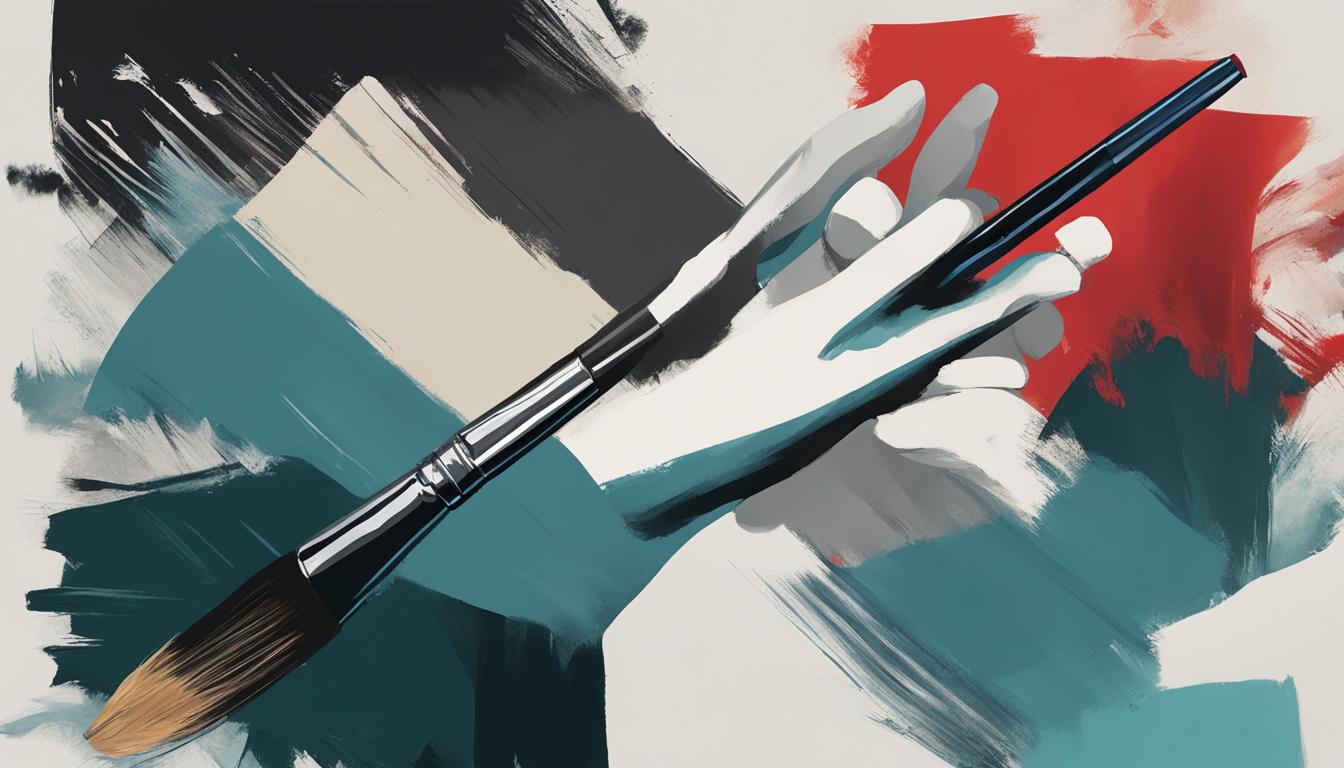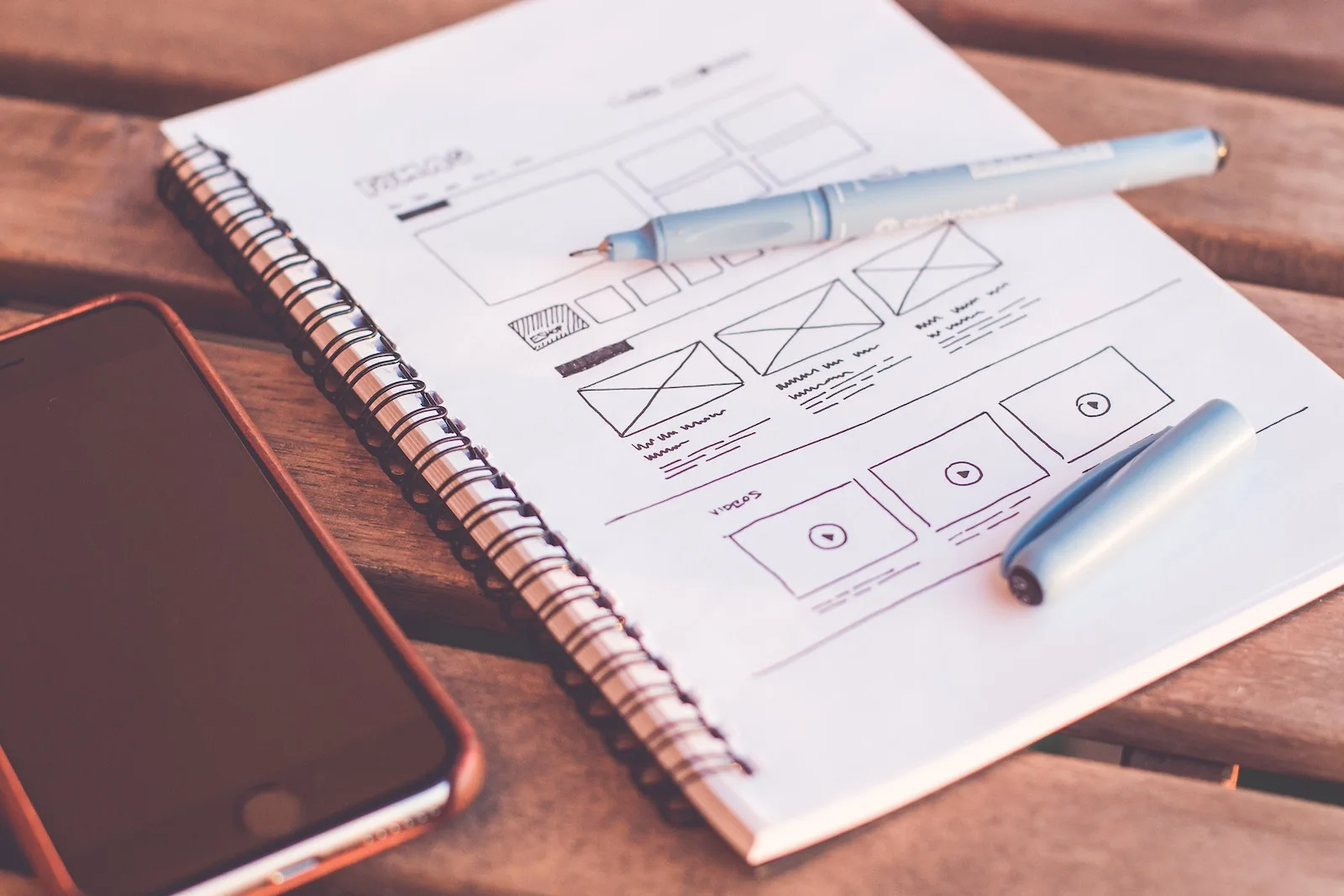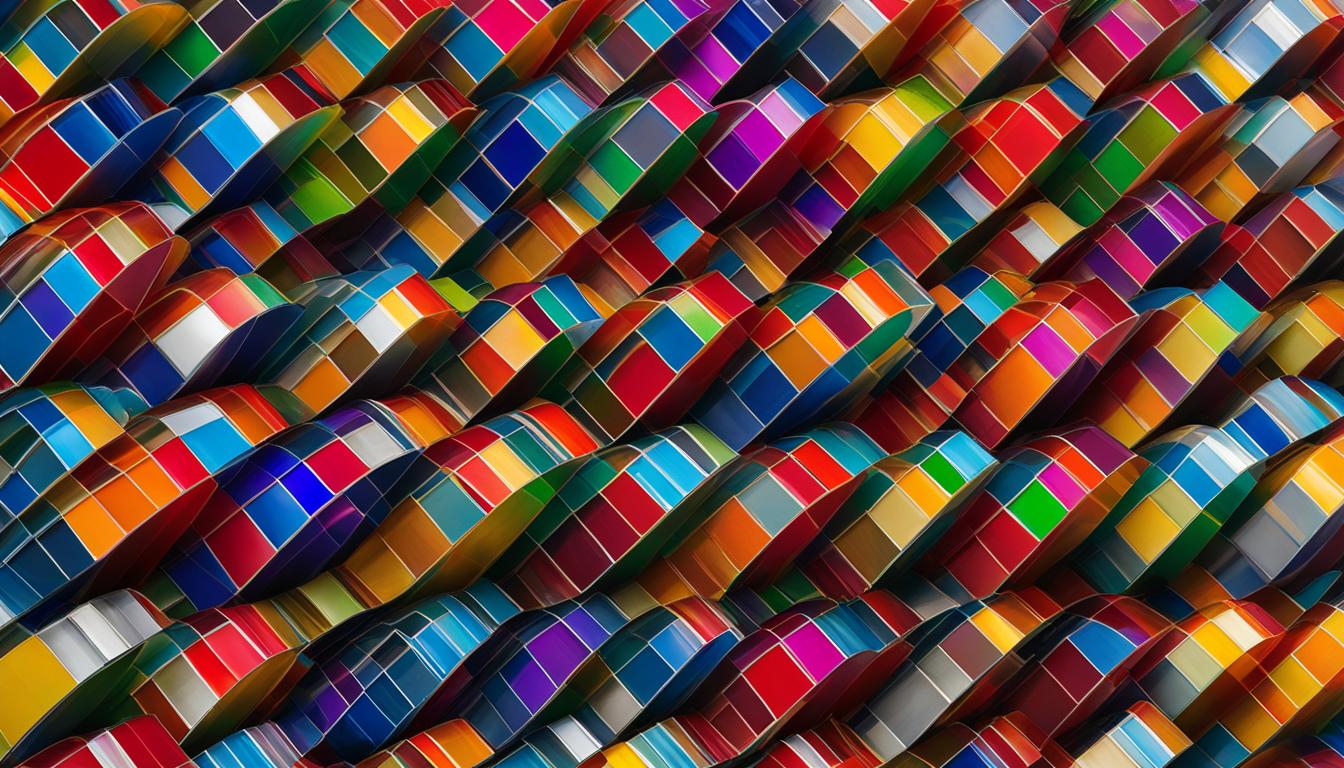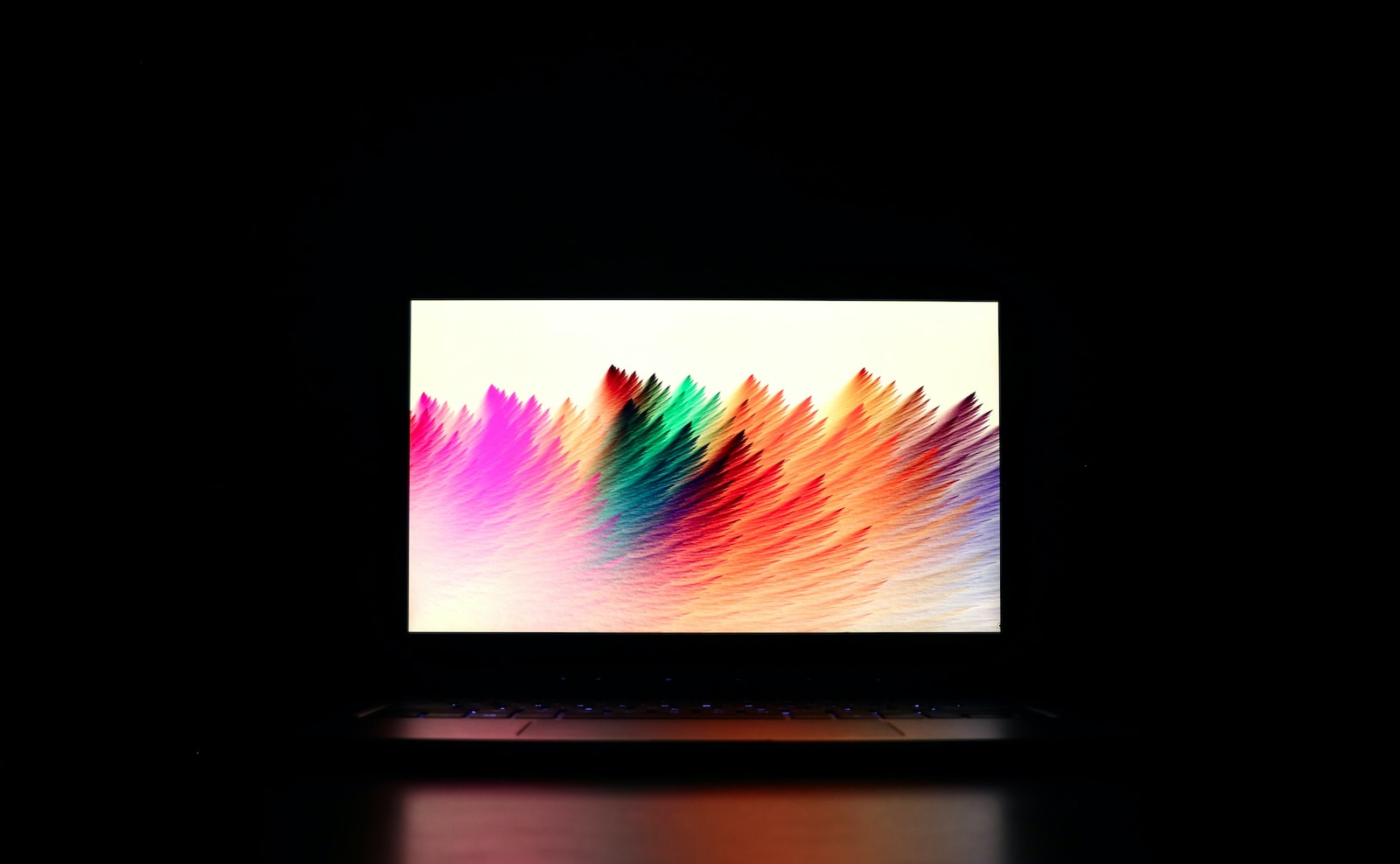Traditional illustration and digital illustration are two distinct techniques used to create artworks. Traditional illustration involves using physical mediums such as pen, pencil, markers, and paints, while digital illustration utilizes digital tools and software. In this article, we will explore the key differences between these two techniques, including their methods, effects, efficiency, and more.
Key Takeaways:
- Traditional illustration involves physical mediums such as pen, pencil, markers, and paints.
- Digital illustration utilizes digital tools and software.
- Key differences between the two techniques include accuracy, alpha locking, amendments, angle, blending, brushes, color choices, cost, delivery, duplication, effects, efficiency, exclusivity, layering, masking, and prints.
- Traditional art techniques have been passed down through generations and are known for their craftsmanship and authenticity.
- Digital art provides a wide range of digital tools and software to create unique and stunning artworks.
What is Digital Art?
Digital art is a form of artistic expression that utilizes digital technologies and software to create visually stunning and unique artworks. Artists can harness the power of digital tools and software, such as Procreate, Maya, Wacom, Blender, Adobe Photoshop, and Adobe Illustrator, to bring their creative visions to life. These digital tools provide artists with a wide range of options for creating digital illustrations, paintings, and designs.
With digital art, artists can explore various digital mediums and techniques, experiment with different brushes and color palettes, and seamlessly make edits and adjustments to their artwork. The flexibility of digital art allows for precise control over details, layering effects, and the ability to easily undo or redo changes. Digital art also offers the opportunity to work in a non-destructive manner, preserving the original artwork while experimenting with different effects and styles.
Digital Art Tools and Software
There are several popular tools and software specifically designed for digital art creation:
- Procreate: A powerful digital illustration app available exclusively for iPad users that provides a wide range of brushes, layering options, and advanced editing features.
- Maya: A 3D computer graphics software widely used in the film, television, and video game industry for creating stunning visual effects and animations.
- Wacom: Known for their high-quality graphic tablets that offer pressure sensitivity and precise pen control, Wacom devices are popular among digital artists.
- Blender: An open-source 3D modeling and animation software that provides a comprehensive set of tools for creating 3D artworks, animations, and visual effects.
- Adobe Photoshop: A well-established software used for image editing, digital painting, and graphic design. It offers a wide range of brushes, filters, and layering options.
- Adobe Illustrator: A vector-based software commonly used for creating illustrations, logos, and graphic designs. It allows for precise control over shapes, colors, and typography.
With these digital tools and software, artists can unleash their creativity and push the boundaries of traditional art techniques. Digital art opens up a world of possibilities, allowing artists to create stunning visual compositions, realistic illustrations, and intricate designs that were once limited by the physical constraints of traditional art mediums.
What is Traditional Art?
Traditional art refers to the practice of creating artworks using physical mediums such as pen and ink, watercolors, markers, and airbrushing. These traditional techniques have been passed down through generations of artists and are known for their craftsmanship and authenticity.
Artists who work with traditional mediums often value the tactile experience of using physical tools and materials. For example, using a pen and ink allows for precise lines and intricate detailing, while watercolors can create vibrant and translucent effects. Each medium has its own unique characteristics, and artists often develop their skills and techniques over time.
Traditional art offers a sense of connection to the past and a rich cultural heritage. It requires patience, practice, and a deep understanding of the specific medium being used. The process of creating traditional art can be seen as a meditative and immersive experience, where the artist is fully engaged with the physical materials.
Advantages of Traditional Art
- Authenticity: Traditional art has a sense of uniqueness and individuality, as each artwork is created by hand.
- Tactile Experience: Working with physical mediums provides a tactile and sensory experience that some artists find rewarding.
- Rich Cultural Heritage: Traditional art techniques have been developed and refined over centuries, contributing to a rich cultural heritage.
| Medium | Characteristics |
|---|---|
| Pen and Ink | Allows for precise lines and intricate detailing |
| Watercolors | Creates vibrant and translucent effects |
| Markers | Produces bold and highly saturated colors |
| Airbrushing | Allows for smooth gradients and subtle shading |
Overall, traditional art offers a unique and authentic approach to artistic expression. While digital art has its advantages, traditional art continues to be valued for its craftsmanship, the connection it provides to cultural traditions, and the tactile experience it offers.
Similarities between Digital and Traditional Art
While digital and traditional art techniques differ in many aspects, there are several key similarities that can be observed. These similarities highlight the foundational elements of artistry that transcend the medium used. Here are some of the notable similarities between digital and traditional art:
- Drawing Skills: Both digital and traditional art require strong drawing skills as a foundation. The ability to accurately depict shapes, lines, and proportions is essential in both mediums.
- Color and Toning: Whether it’s through mixing paints or selecting digital color palettes, artists in both digital and traditional art must have an understanding of color theory and toning techniques to create visually appealing artworks.
- Similar Mediums: In terms of tools and materials, there is overlap between digital and traditional art. Both mediums utilize pens, pencils, markers, and brushes to bring their artistic visions to life.
- Canvas: Both digital artists and traditional artists need a surface on which to create their artworks. Although digital artists work on a digital canvas, their creative process still involves visualizing the composition and layout of their artwork.
- Brushes: While the brushes used in digital art are virtual and customizable, they are designed to mimic the characteristics of traditional brushes. This allows digital artists to achieve similar effects and textures as traditional artists.
These similarities demonstrate that despite the advancements in digital technology, the fundamental principles of art remain consistent across different mediums. Artists can leverage these shared aspects to explore new possibilities and create artworks that blend the best of both digital and traditional techniques.
Digital vs. Traditional in the Creative Process
While there are similarities between digital and traditional art, it’s important to note that each medium also has its own unique characteristics and challenges in the creative process. Digital artists can take advantage of the versatility and convenience of digital tools, allowing them to experiment with different effects and undo mistakes easily. Traditional artists, on the other hand, must rely on manual techniques and materials, which often require more time and effort to achieve desired results.
Despite these differences, many artists embrace a hybrid approach that combines digital and traditional techniques. This allows artists to capitalize on the strengths of each medium, creating artworks that are both visually striking and rooted in artistic tradition.
Summary
Although digital and traditional art techniques have their distinct qualities, they also share similarities in terms of drawing skills, color and toning, mediums, canvas, and brushes. Both mediums require skill and creativity in their execution, with artists utilizing their understanding of these foundational elements to produce captivating artworks. By recognizing the common ground between digital and traditional art, artists can leverage these shared aspects to push the boundaries of their creativity and create art that resonates with audiences.
| Similarities between Digital and Traditional Art |
|---|
| Drawing Skills |
| Color and Toning |
| Similar Mediums |
| Canvas |
| Brushes |
Differences between Digital Art vs Traditional Art
When comparing digital art and traditional art, several key differences emerge across various aspects of the artistic process. These differences include factors such as accuracy, alpha locking, amendments, angle, blending, brushes, color choices, cost, delivery, duplication, effects, efficiency, exclusivity, layering, masking, and prints. Understanding these distinctions can help artists determine which medium best suits their artistic goals and preferences.
Accuracy
Digital art allows for precise control and accuracy due to features like zooming in and using digital tools that streamline the creation process. On the other hand, traditional art requires stability in hand movements and manual control, which can lend a unique charm but may also lead to slight imperfections.
Alpha Locking
In digital art, alpha locking enables artists to paint within specific objects or areas without affecting the surrounding elements. This feature provides more flexibility and efficiency in the creation process. In contrast, traditional art requires careful brush control and masking techniques to achieve similar effects.
Amendments and Adjustments
One of the advantages of digital art is the ability to easily make amendments and adjustments. Artists can undo previous actions, experiment with different options, and edit their work with precision. Traditional art, on the other hand, allows for manual amendments but requires more effort and skill to correct mistakes or make significant adjustments.
| Aspect | Digital Art | Traditional Art |
|---|---|---|
| Accuracy | Provides precise control and the ability to zoom in for intricate details | Requires stability in hand movements and can result in unique imperfections |
| Alpha Locking | Allows for painting within objects or areas without affecting the surrounding elements | Requires careful brush control and masking techniques for similar effects |
| Amendments and Adjustments | Easy to make corrections and adjustments with undo capabilities | Manual amendments require more effort and skill |
| Angle | Offers the flexibility to easily adjust the angle or perspective of the artwork | Requires a fixed angle or extensive rework to change the perspective |
| Blending | Provides various digital brushes and tools for seamless color blending | Requires manual blending techniques with traditional mediums |
| Brushes | Digital art offers a wide range of customizable brushes and digital effects | Traditional art uses physical brushes with limited options for customization |
| Color Choices | Offers a vast array of colors, gradients, and digital effects for easy experimentation | Requires mixing paints to achieve desired colors and tones |
| Cost | Generally more cost-effective due to the absence of physical materials | Can be more expensive due to the need for materials and manual delivery |
| Delivery | Allows for easy digital delivery and sharing of artwork | Requires physical reproduction and delivery to clients |
| Duplication | Enables effortless duplication and replication of artwork | Requires individual reproduction or limited edition prints |
| Effects | Provides access to a wide range of digital effects and filters | Relies on physical techniques and materials for artistic effects |
| Efficiency | Offers efficient workflow with software features like layers and shortcuts | Requires manual layering and extensive time for specific techniques |
| Exclusivity | Artworks can be easily reproduced, limiting exclusivity | Each physical artwork is unique and one-of-a-kind |
| Layering | Provides a non-destructive workflow with multiple layers for easy editing and organization | Requires careful planning and layering techniques with physical mediums |
| Masking | Allows for precise masking and selection techniques with ease | Requires manual masking and precision with traditional tools |
| Prints | Enables easy digital reproduction and printing | Requires manual reproduction and specialized printing techniques for quality prints |
These differences illustrate that both digital art and traditional art have their own unique strengths and characteristics. Artists can choose the medium that aligns with their artistic vision, personal preferences, and desired outcomes. Some artists may prefer the flexibility, efficiency, and accessibility of digital art, while others may appreciate the authenticity, craftsmanship, and physical presence of traditional art.
By understanding and embracing these differences, artists can make informed decisions about which medium to use and explore innovative ways to combine the advantages of both digital and traditional art techniques.
Is Digital Art better than Traditional Art?
In the age of digital technology, the debate between digital art and traditional art continues to spark discussions among artists, critics, and enthusiasts. The question of whether digital art is better than traditional art is subjective and largely depends on personal preferences, artistic goals, and the desired outcome.
Advantages of digital art include its cost-effectiveness and ease of correction. Digital art provides artists with the ability to make changes, amendments, and adjustments easily using software tools. This flexibility allows for experimentation and exploration without the fear of irreversible mistakes. Furthermore, digital art offers access to a wide range of tools, effects, and techniques that can enhance the artistic process and result in unique and visually stunning artworks.
On the other hand, traditional art possesses its own set of advantages that cannot be replicated digitally. Traditional art offers a sense of authenticity and craftsmanship that can be appreciated by art connoisseurs. The physicality of traditional mediums, such as pen and ink, watercolors, and markers, adds a tangible quality to the artwork. Traditional art also allows for a more hands-on approach, requiring artists to develop stable hand movements and master the techniques of their chosen medium. Additionally, traditional art creates one-of-a-kind pieces that possess a sense of exclusivity and uniqueness.
Advantages of Digital Art
- Cost-effectiveness: Digital art eliminates the need for expensive physical materials, making it a more affordable option for artists.
- Easy correction: Digital tools allow for quick and easy amendments and adjustments without the fear of ruining the artwork.
- Wide range of tools and effects: Digital software provides artists with access to a multitude of brushes, textures, and special effects that can enhance their artworks.
Advantages of Traditional Art
- Authenticity and craftsmanship: Traditional art techniques have been passed down through generations and possess a unique sense of authenticity.
- Tangible quality: Physical mediums add a tactile element to the artwork, creating a deeper connection with the viewer.
- Exclusivity and uniqueness: Traditional art produces one-of-a-kind pieces that cannot be replicated digitally.
Ultimately, whether digital art is better than traditional art is a matter of personal preference. Both techniques have their own advantages and can coexist harmoniously. Many artists today are embracing a hybrid approach that combines traditional and digital techniques, allowing them to leverage the unique qualities of each medium. The choice between digital and traditional art depends on the artist’s artistic vision, desired outcome, and the story they want to convey through their artwork.
Bridging the Gap between Digital and Traditional Illustration
Rather than viewing digital and traditional illustration as competing techniques, many artists are now embracing a hybrid approach that combines the best of both worlds. This hybrid approach involves using traditional techniques, such as hand-drawn sketches, and then digitizing them for further refinement. By complementing each other, digital and traditional illustration techniques open up new possibilities for artists to create unique and captivating artworks.
One way to bridge the gap between digital and traditional illustration is by combining traditional and digital techniques. Artists can start with a traditional sketch or painting and then scan or photograph it to bring it into the digital realm. This allows for easier edits, adjustments, and experimentation with different effects and colors without compromising the initial handcrafted authenticity of the artwork.
In addition to combining techniques, advancements in digital technology have also played a significant role in bridging the gap between the two approaches. Software and brush presets now mimic traditional mediums, giving artists the ability to achieve similar textures and effects digitally. This blurs the line between digital and traditional art and allows artists to seamlessly transition between the two.
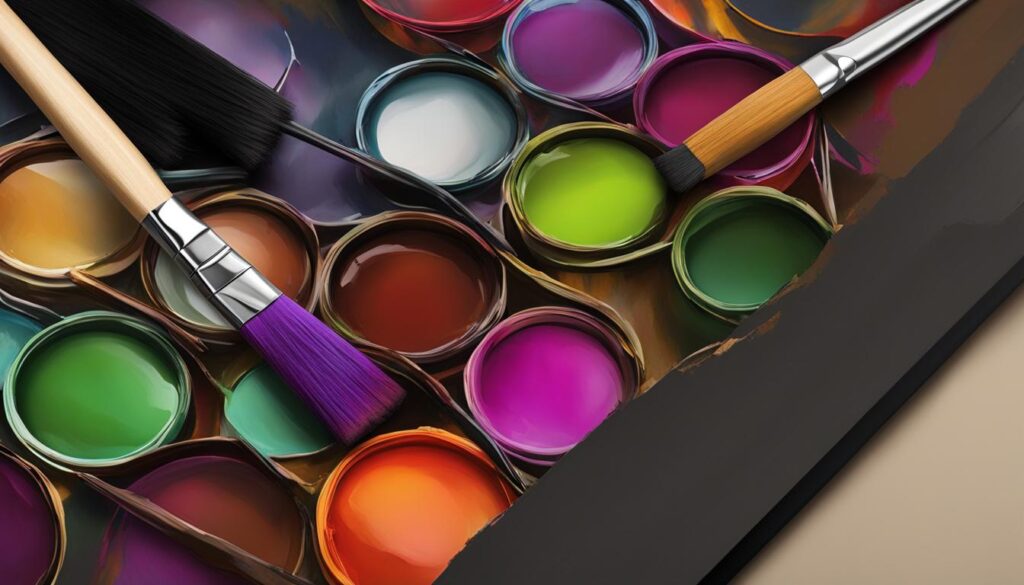
Benefits of a Hybrid Approach
- Expanding creative possibilities: By embracing a hybrid approach, artists can take advantage of the unique features and tools offered by both digital and traditional techniques, expanding their creative repertoire.
- Efficiency and flexibility: The flexibility of digital tools allows for easier experimentation, quick edits, and the ability to work on multiple layers, while traditional techniques provide a tactile and hands-on experience.
- Preserving artistic authenticity: Starting with a traditional sketch or painting adds a personal touch and authenticity to the artwork, which can be enhanced and refined digitally without losing the initial character.
- Blending styles: Combining digital and traditional techniques enables artists to blend different styles and create unique visual aesthetics that stand out.
Conclusion
In conclusion, the differences between traditional and digital illustration techniques are vast and encompass various aspects. Digital art offers advantages in terms of accuracy, alpha locking, amendments, angle adjustments, blending options, a wide variety of brushes, and easy access to different color choices. It also provides efficiency in terms of undo capabilities, layering options, and digital delivery. On the other hand, traditional art showcases authenticity and craftsmanship, offering a unique charm that cannot be replicated digitally.
While digital art provides convenience and cost-effectiveness with its ability to make digital prints and quickly make edits, traditional art requires stability in hand movements and manual amendments, making it a process that requires time and patience. Additionally, traditional art involves the physicality of mixing paints and delivering the artwork manually to clients. Both techniques have their own strengths and can be equally valuable in the art world.
As artists navigate the world of illustration, it is important to find a balance between traditional and digital techniques. Many artists are embracing a hybrid approach that combines the best of both worlds. This involves using traditional techniques, such as hand-drawn sketches, and then digitizing them for further refinement. By leveraging the flexibility and efficiency of digital tools while maintaining the artistic realism of traditional illustration, artists can create compelling and engaging artworks that bridge the perceived gap between the two approaches.
FAQ
What are the differences between traditional and digital illustration techniques?
Traditional illustration refers to artworks created using physical mediums, while digital illustration involves creating art using digital tools and software.
What is digital art?
Digital art refers to artworks created using digital technologies and software, such as Procreate, Maya, Wacom, Blender, Adobe Photoshop, and Adobe Illustrator.
What is traditional art?
Traditional art refers to artworks created using physical mediums, such as pen and ink, watercolors, markers, and airbrushing.
What are the similarities between digital and traditional art?
Both techniques require drawing skills, an understanding of color and toning, and the use of similar mediums like pens, pencils, markers, and brushes. Additionally, both digital and traditional art require a canvas or surface to work on.
What are the differences between digital art and traditional art?
Digital art allows for easy control of accuracy, alpha locking for painting within objects, amendments and adjustments with undo capabilities and layering options, angle adjustments, blending of colors, and access to various brushes. Traditional art requires stability in hand movements, manual amendments and adjustments, and has limited accessibility to different angles, blending, and brush options. Traditional art also involves making color choices by mixing paints and can be more costly due to materials and manual delivery to clients.
Is digital art better than traditional art?
Whether digital art is better than traditional art is subjective and depends on personal preferences and the desired outcome. Digital art offers advantages in terms of ease of correction, cost-effectiveness, and digital delivery. Traditional art, on the other hand, offers a unique and authentic touch, and the physical artwork is one-of-a-kind.
How can digital and traditional illustration techniques complement each other?
Many artists are now embracing a hybrid approach that combines traditional techniques, such as hand-drawn sketches, with digital tools for further refinement. This approach maintains the artistic realism of traditional illustration while utilizing the flexibility and efficiency of digital tools.
 Skip to main content
Skip to main content